
Organic gardening – and in particular, vegetable gardening and growing fruit organically – gives you the peace of mind of knowing exactly what has gone into producing your food. No man-made chemicals, fertilisers and nasties. It also results in the freshest and tastiest fruit and vegetables possible.
Read on for our simple steps on how create an organic garden. With top tips on companion planting, plus suppliers and recommendations to find the best organic fruit and vegetables available, you'll be able to enjoy all the benefits of creating a more environmentally-friendly garden in no time at all.
- For more garden ideas and inspiration, look to our feature.
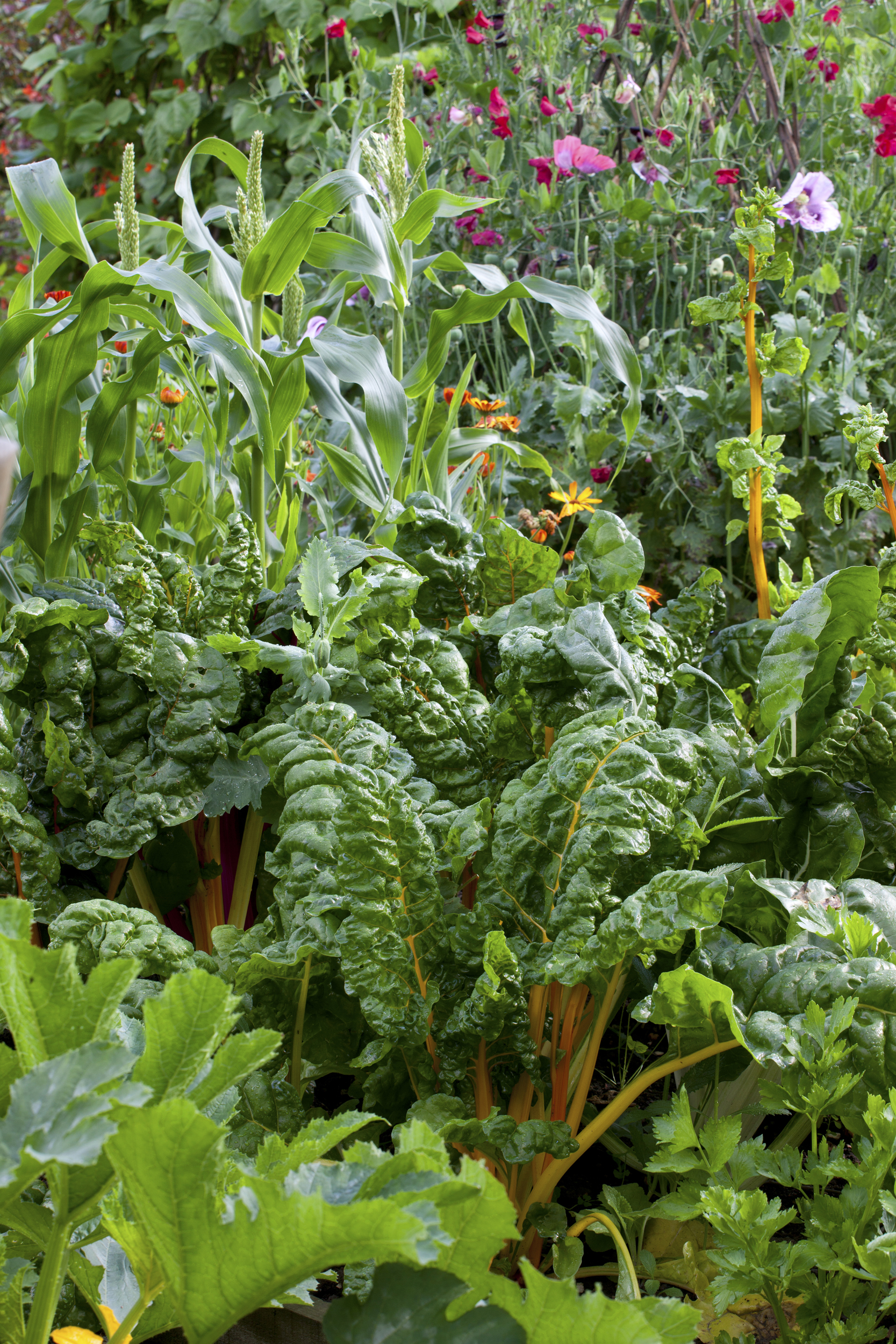
In an organic garden mono cropping should be avoided. Mix some crops, such as chard and corn, among flowers and share any excess seeds with friends and family so you only grow what you need
- Are you designing a garden from scratch? If so be sure to take a look at our feature.
What is meant by organic gardening?
First things first: what do we mean when we talk about organic gardening? Organic gardening involves using less man-made, chemical substances, such as synthetic fertilisers and pesticides, but is also involves a more holistic approach to gardening. Organic gardening requires an awareness of our wider impact on the environment, so gardening in a more environmentally-friendly way.
In an organic garden where you grow your own produce, you would look to adopt some or all of the following organic gardening practices:
- use of natural pest controls
- companion planting
- sustainable fertiliser
- home-made compost
- conserve natural resources - such as rainwater collecting systems
- propagate your own plants from cuttings or seeds
- reuse and recycle - from containers and tools to furniture
- avoid plastics
- encourage wildlife
- seed share with friends and neighbours
- use permeable surfaces for hard landscaping, such as paths between vegetable beds, to allow rainwater to soak into the ground, and where possible use recycled materials and FSC certified wood, such as when building raised beds for vegetable crops
Successful organic gardening requires a dedicated and informed approach. But it is a cost worth paying for avoiding potentially harmful gardening practices.
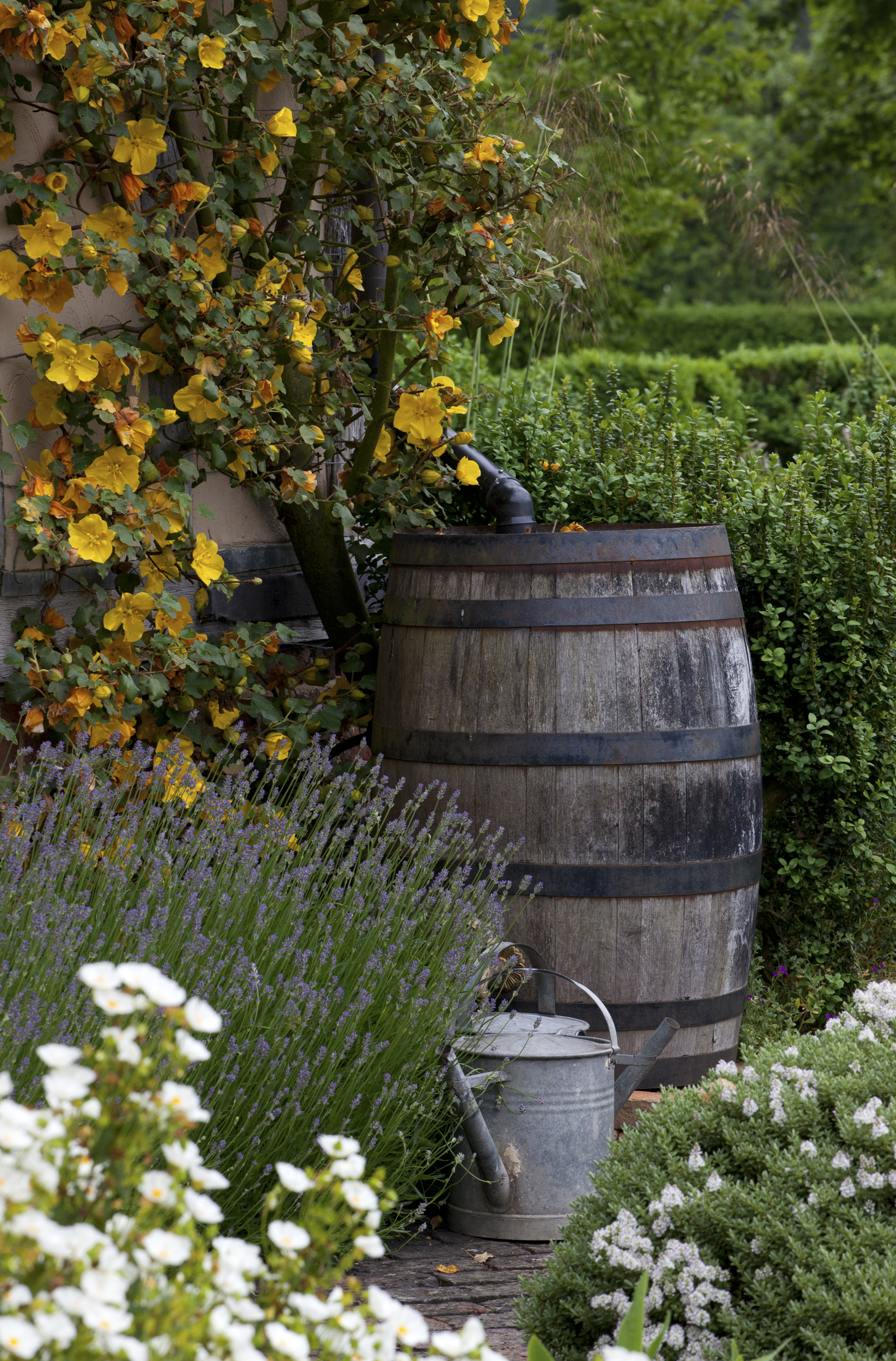
Organic gardening involves awareness of your impact on the wider environment. Where possible, use natural resources, such as collecting rainwater in water butts
How do I start an organic garden
An organic garden does not fend for itself. If you want to try organic gardening, you need to know how you can strengthen plants’ health naturally and learn how to use alternative ways of warding off pests. Growing your own organic vegetables and fruit does not mean you can't enjoy flowers, too - much to the contrary. Fruit and vegetable crops will benefit from the pollinators that come to enjoy your flowers – the brighter the better.
There are five main principles to bear in mind as you learn how to garden organically: a good site, healthy soil, biodiversity, sustainable resources, and avoidance of chemicals.
1. Choose the right spot for your organic garden
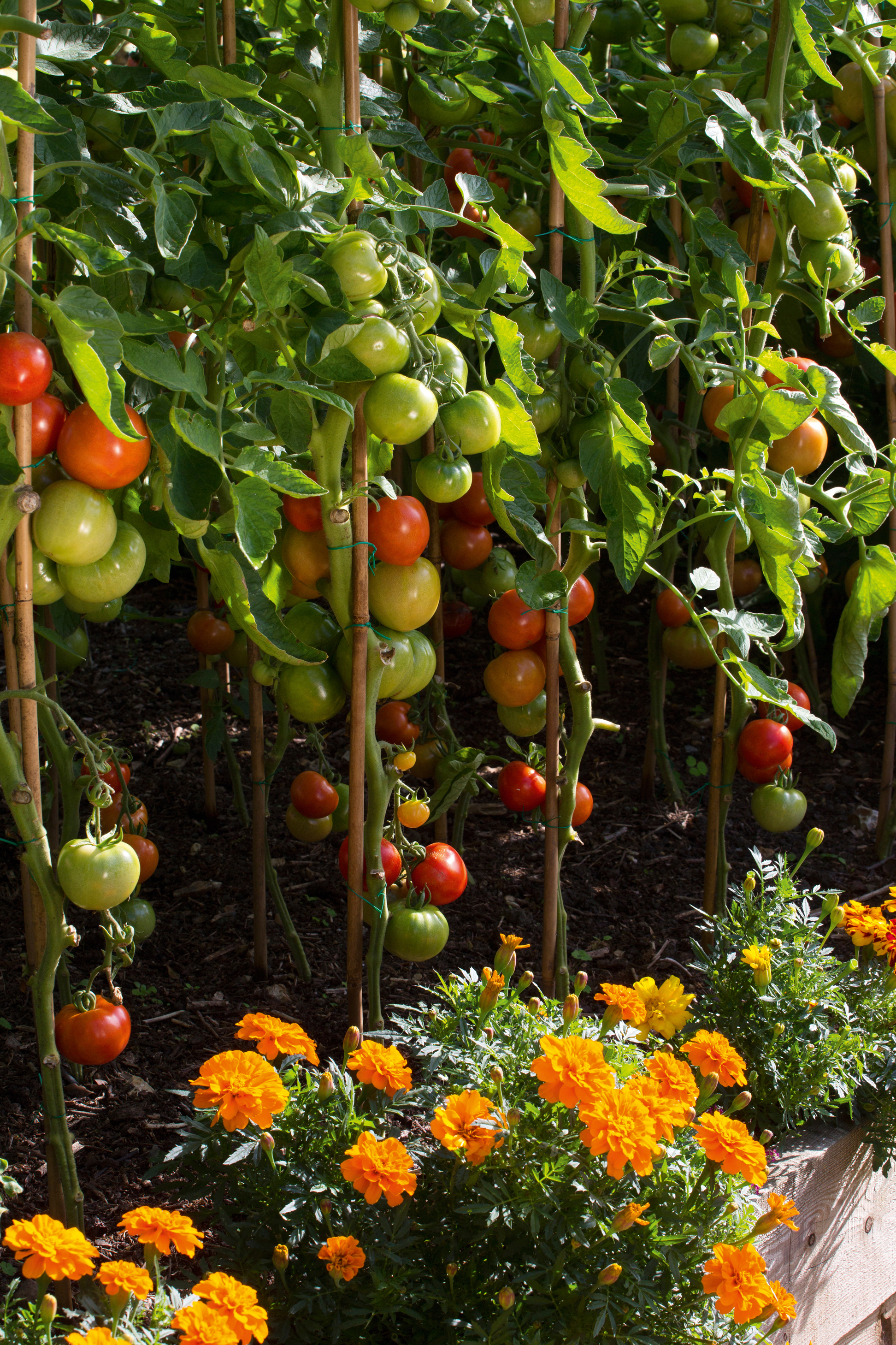
Organic gardening involves the use of companion planting for natural pest control and to help increase crop yield
Select a sunny location for your organic vegetable garden – a spot which gets eight hours of sun a day if possible.
Most fruit and vegetables need plenty of light and heat to photosynthesise. If you only have part sun, there are still good options of what you can grow, though, such as lettuce, greens and some herbs.
Top tips:
- Ideally, you need a level, well-draining site for your organic vegetable garden, protected from wind by hedging, a windbreak or walls;
- Consider the practicalities of access to water, tools, compost, maintenance and harvesting;
- If it’s easy to regularly pop out and check on the crops, or quickly harvest something to add to your meals, it will be a practical and useful addition to your organic garden;
- Be realistic about how much you can manage and the amount of produce you will eat;
- It’s best to start small so you don’t get disheartened and and give up;
- You can grow a lot of food in a small raised bed or pots. See our guide on how to make raised beds
Use our guide to container gardening in small spaces to discover how to grow organic fruit and vegetables on a sunny patio.

You can grow a lot of crops in raised beds, which can be made from recycled materials
2. Create the perfect soil for organic gardening

A healthy vegetable plot in an organic garden
Homemade compost recipe
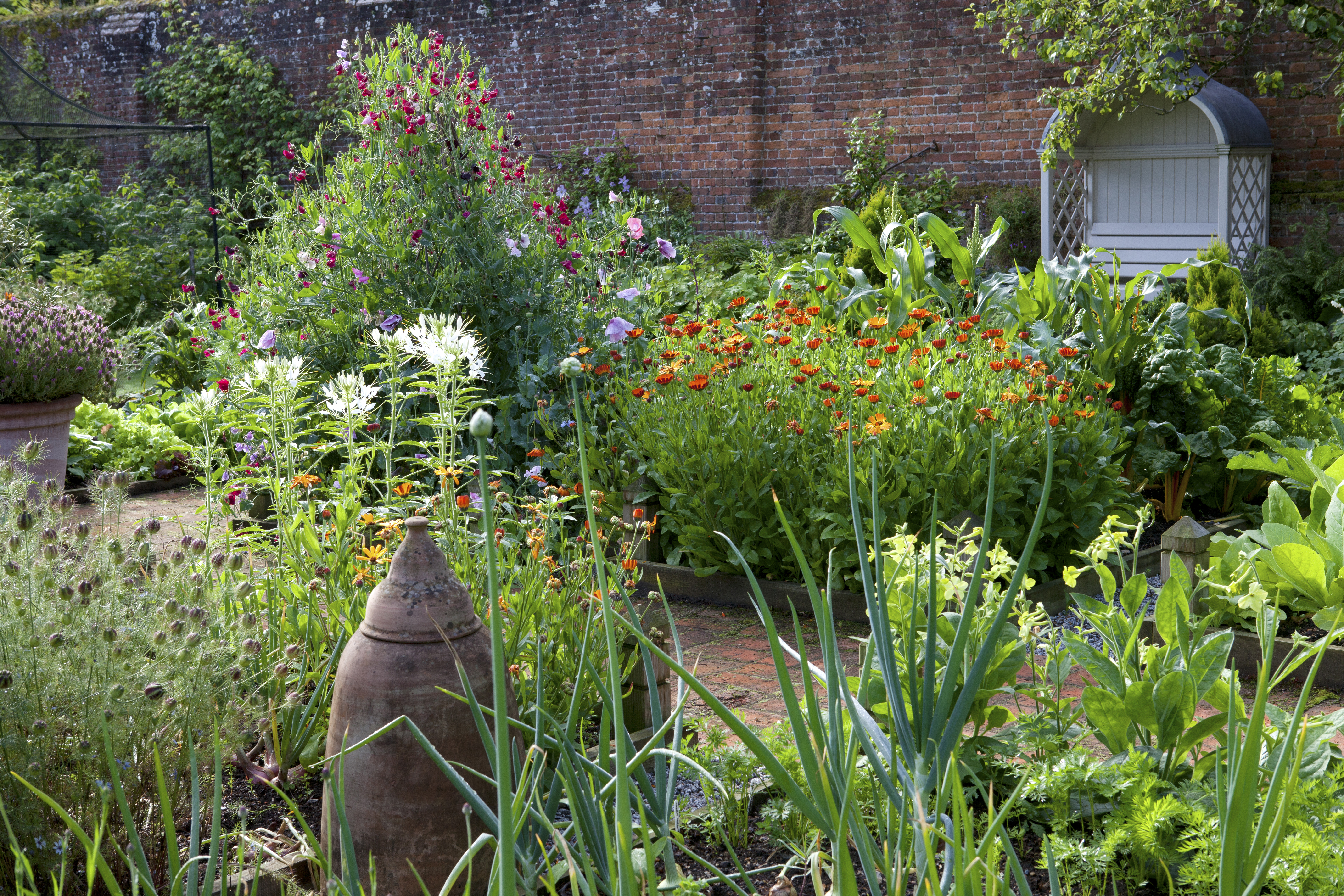
Penny Hemming, head gardener at Riverford Organic, offers this basic recipe for a nice, crumbly, rich-smelling, loose-textured compost within six months – a fantastic soil conditioner:
Ingredients
1/3 green material, such as stems, lawn clippings, kitchen waste, tea bags
2/3 brown material, such as twigs, roots, straw, ashes, wood chippings
Air is important for decomposition, so start the heap with a load of broken branches. Don’t add cooked foods, diseased waste or weeds.
Method
Add the ingredients in layers. Water occasionally. Cover to encourage build up of heat. Turn every few weeks.
Good soil, abounding with nutrients and texture and full of life, is vital, especially with organic gardening.
Healthy, fertile soil with a good structure allows plants to absorb water and nutrients, and encourages strong growth.
Feed the soil in your organic garden with homemade compost, rotted manure or leaf mould. These bulky materials release nutrients slowly, improve soil conditions, and stimulate essential micro-organisms.
To learn how to make compost be sure to use our guide.
Top tips:
- Growing green manures (plants that benefit the soil), such as Phacelia tanacetifolia, which also attract pollinating insects, is another organic technique for soil improvement;
- Natural liquid feeds can help your plants in times of stress;
- Mycorrhizal fungi improve root nutrition uptake;
- Worms aerate the soil and improve drainage;
- The ‘No Dig’ method uses thick mulches to suppress weeds.
The 'no dig' method of gardening aims for a minimal disturbance of the soil, allowing natural organisms to thrive and increasing the soil's overall health. The aim is to cover the soil with a rich, organic matter and exclude the light so weeds don't grow, so this method is most suited to smaller spaces, such as when growing organically in raised beds.
3. Select organic fruit and vegetables to grow

Vegetables from an organic garden are hard to beat when it comes to taste
Organic nurseries and suppliers
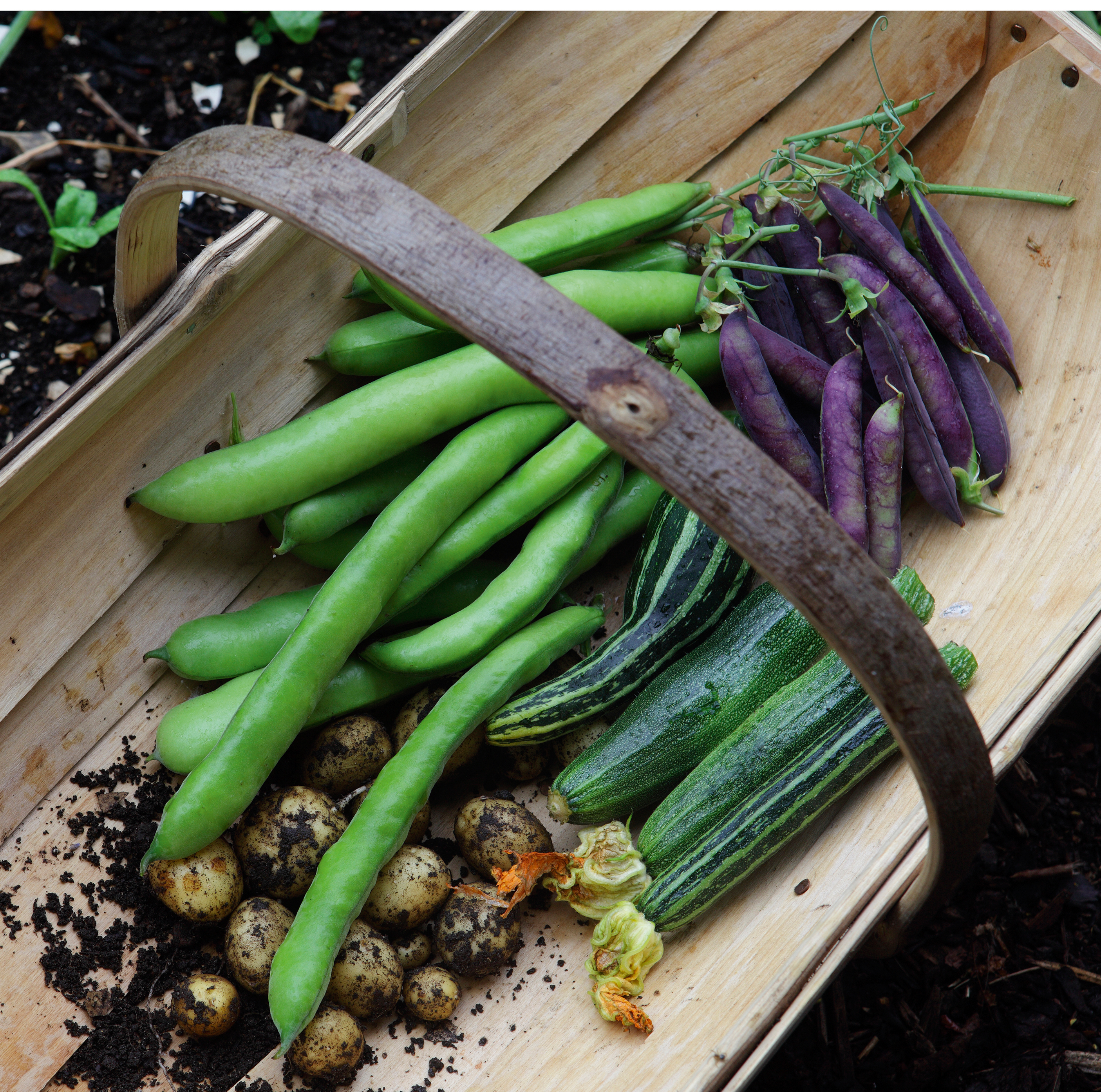
Garden Organic – advice, organic seeds and plants.
The Organic Gardening Catalogue – seeds and supplies.
Unwins Seeds – online organic vegetable seeds.
Tamar Organics – seed and organic garden supplies.
Organic Plants – offers a plants-by-month delivery option.
Walcot Organic Nursery – organic fruit trees.
It’s worth hunting out organically grown seeds and plants.
Conventionally grown plants are often already loaded with pesticides and chemical fertilisers, or may be genetically modified – exactly the types of things you’re trying to avoid.
See our suggestions for organic nurseries and online suppliers (above, right). Also look out for ‘organic’ labels at your local garden centre.
As with all gardening, use the right plants in the right place when organic gardening. Select strong, healthy plants that suit your conditions, and look for naturally disease-resistant varieties.
It’s well worth doing some research so you have a clear understanding of the kind of care each crop needs.
See our top picks of organic fruit and vegetable options below.

4. How to care for plants when organic gardening
Now you’ve sited your organic garden, enriched the soil and selected your crops, it’s time to start planting and looking after your garden.
Pay attention to what your plants need, including watering the roots not the foliage.
Regularly inspect the plants and stay vigilant so you catch pest and disease problems right away.
At the heart of organic gardening is to keep your growing area in good health, rather than just pest- and disease-free. A diverse and vigorous growing system, good hygiene, and close observation all help prevent problems.
You can suppress and control weeds naturally with a layer of bark mulch, composted straw or leaf mould, and removing any that pop up.
Physical barriers, such as netting or cages, are a good idea to protect your ripening crops.
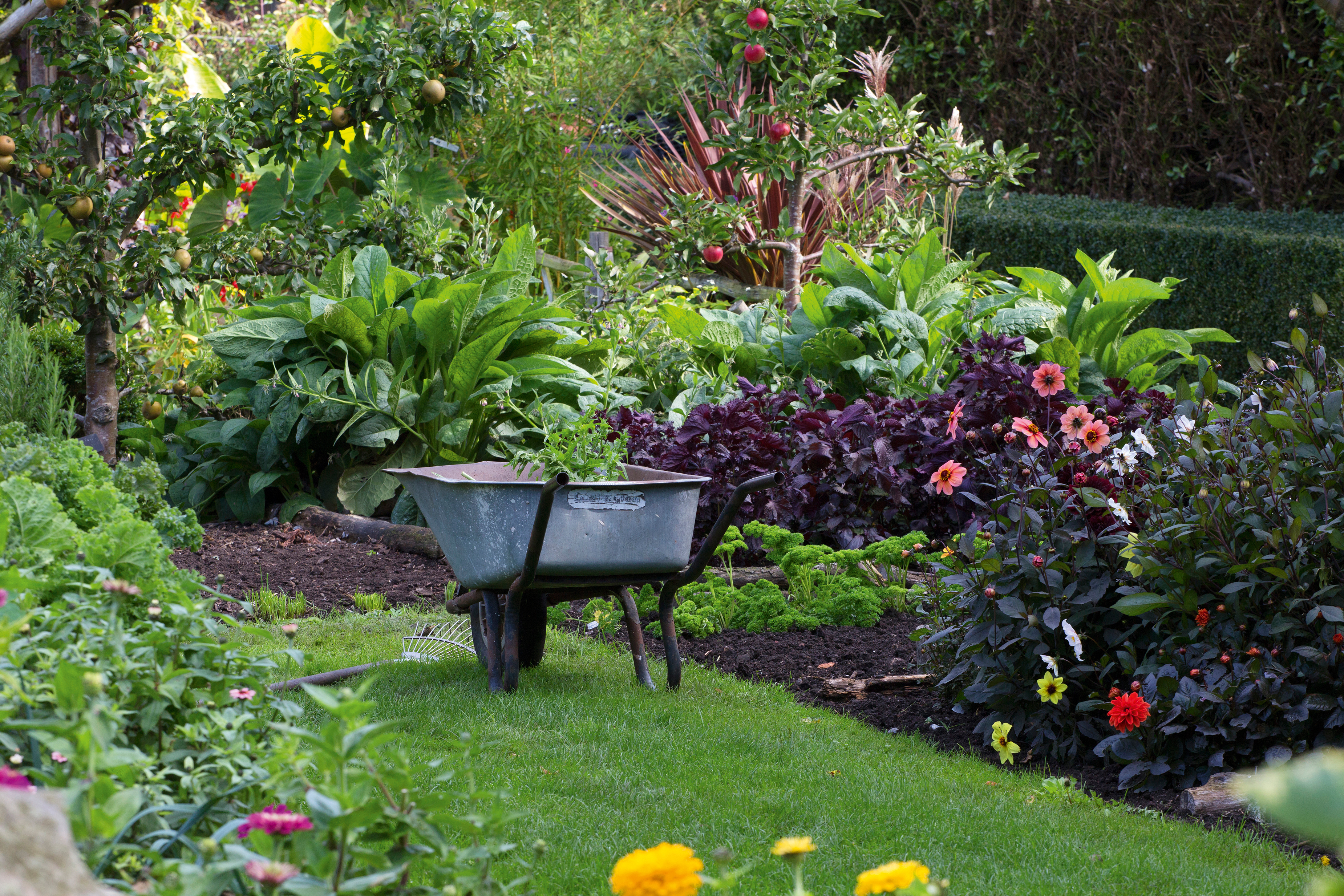
5. Encourage biodiversity for easier organic gardening
In an organic garden, encourage a food chain balance to make wildlife work for you, from ladybirds eating greenfly to frogs devouring snails.
Brightly coloured flowers will attract a wide variety of insects, and the more bees you attract to the garden, the more pollination and larger yields you’ll have.
You can use biological controls for any pests. Remember to rotate your crops as this prevents build-up of diseases in the soil. Keep an eye on the watering; you don’t want your plants stressed as this makes them vulnerable to attack.
Certain crops help each other. For example, plant a bed with sweetcorn, beans and squash together. Each plant provides natural shelter and protection for the other. The large leaves of the squash plants shade the sweetcorn’s roots from sunlight. They also act as natural mulch by suppressing weeds and preventing moisture from evaporating from the soil’s surface. The tall corn stems provide a sturdy support for beans to climb up. In turn, the beans fix nitrogen into the soil.
Use our guide to find out how to create your own wildlife garden.
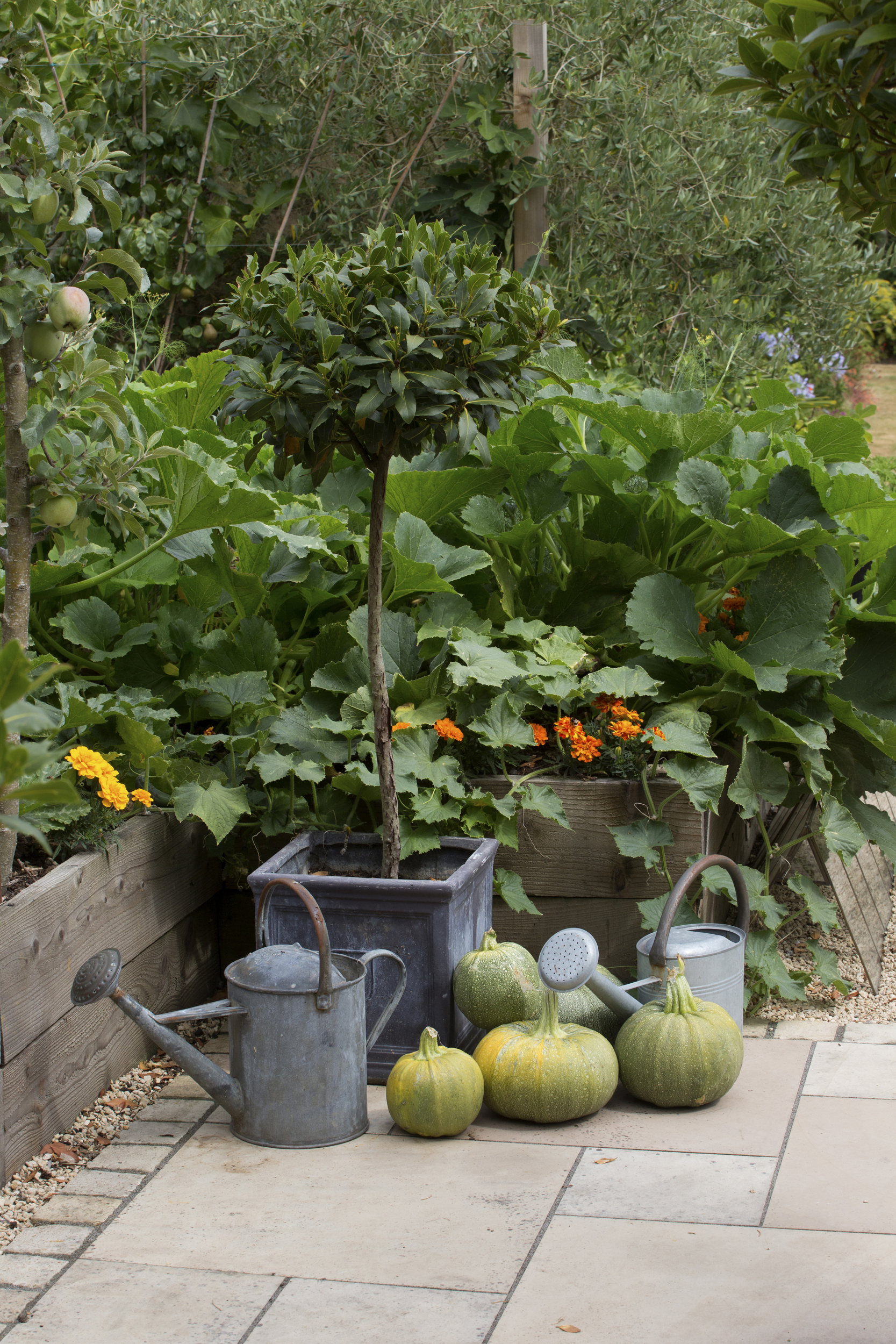
Organic gardening does not use man-made, chemical substances
Companion planting for an organic fruit and veg plot
Use companion planting to your organic vegetable garden’s advantage. Growing strongly scented plants beside your crops either confuses pests or attracts them away from your produce.
- Basil – deters whitefly on tomatoes and kale.
- Chives – deter aphids and carrot root fly.
- French marigolds – deter aphids and whitefly, and attract hoverflies, whose larvae eat aphids; plant with tomatoes, aubergines and chillies.
- Rosemary – deters carrot fly.
- Sage – confuses pests of brassicas and deters carrot fly.
- Nasturtium – sacrificial crop, lures aphids away from beans and attracts beneficial insects.
- Dill – attracts hoverflies and wasps to eat aphids.
- Mint and sage – repel slugs; plant with cabbages and lettuces.
- Yarrow – attracts ladybirds and hoverflies.
- Fennel – attracts hoverflies and ladybugs, which prey on aphids.
- Lavender – attracts pollinators and deters aphids; plant with carrots and leeks.
- Nettles – attract cabbage white butterflies, keeping them away from brassicas.
- Find out about growing lavender in our guide and should you be looking to perfect your herb garden, we can help too.
12 veg or fruit crops to try in an organic garden
Try these suggestions for organically grown edibles. But remember: organic gardening is not for the perfectionist – you need to accept the odd nibbled leaf or imperfect-looking fruit and vegetable.
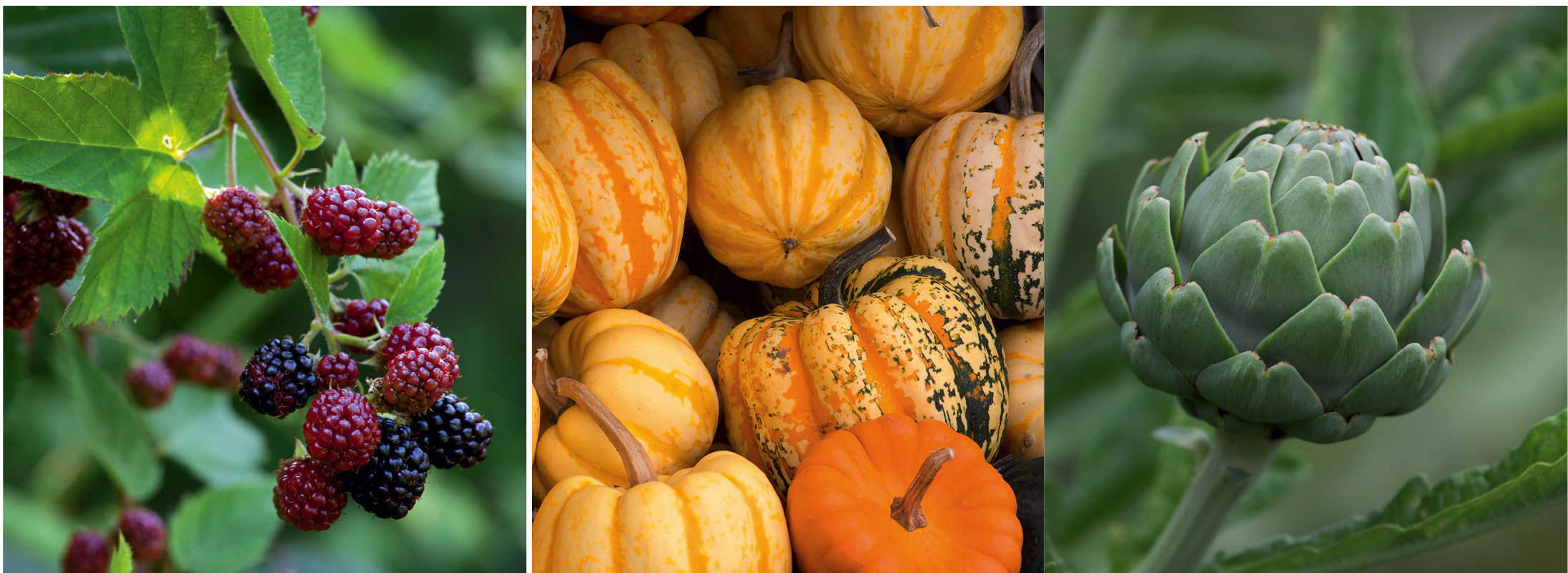
(Above, left to right)
Blackberries Easy to grow, blackberries are low maintenance and abundant in fruit. Plant between November and March. Water well in summer. Cut out the old fruiting wood after harvesting and tie in new canes in autumn. Yield is heavier if planted near other different cultivar.
Squashes There are lots of different varieties – some summer, some winter. Sow in spring outside where they are to grow. Thin seedlings and keep the soil moist. Keep an eye out for slugs. Can be grown in large containers.
Artichokes Very easy to grow from seed in spring. They need a sunny, sheltered position in well-mulched soil. Not only are they delicious to eat, but the plants are spectacular with architectural silver foliage and large purple flowers if left unharvested. Give them plenty of room as they can spread to 1m.
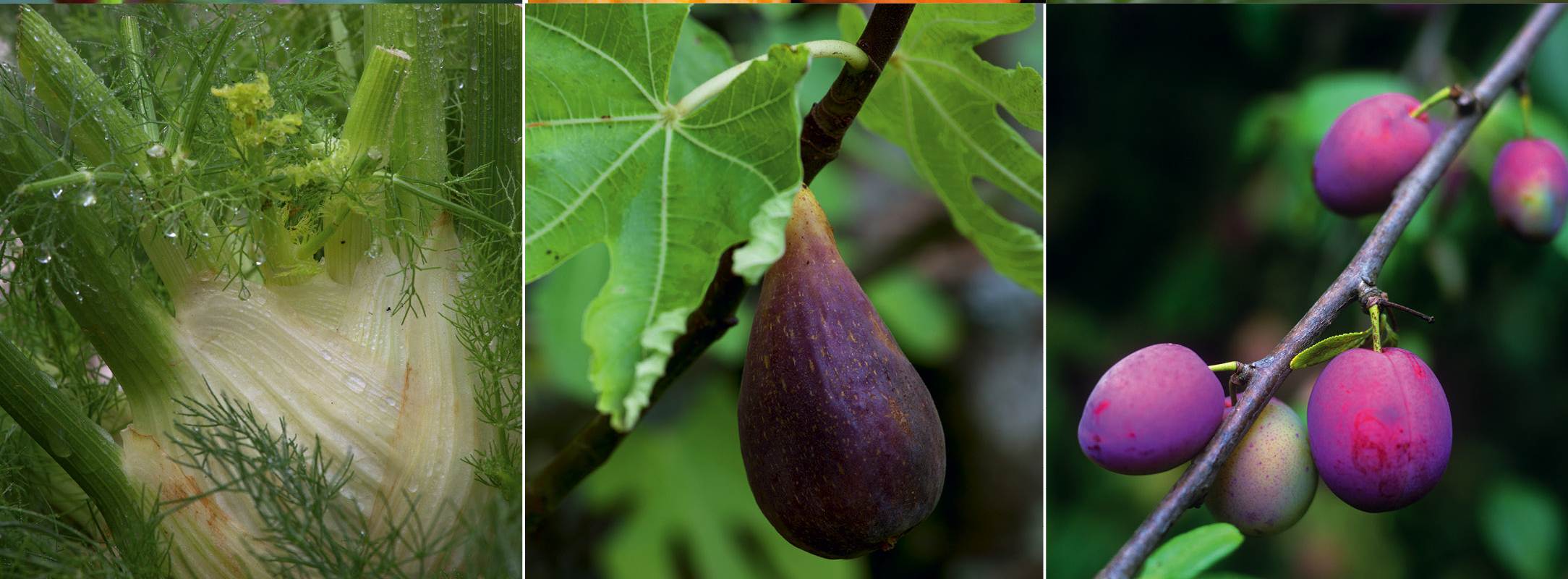
(Above, left to right)
Fennel Considered both a vegetable and a herb, sow fennel seeds as soon as the soil can be worked early in the season. Incorporate plenty of organic matter. Fennel is not difficult to grow and is a popular addition to organic gardens because it attracts ladybugs, which are natural predators of some of the most insidious garden pests.
Figs Plant against a warm, south-facing wall or in a container, standing on pot feet to prevent waterlog. Long-lived and needs sun to ripen the fruit. Figs are ripe when the stalk bends and the hanging fruit produces a droplet of sugar on the base.
Plums Not difficult to grow but need a warm, frost-free spot in well-drained, moisture-retentive soil. Mulch in mid spring and thin out young fruit to avoid laden branches breaking. Fallen fruit is adored by butterflies so leave them a few.
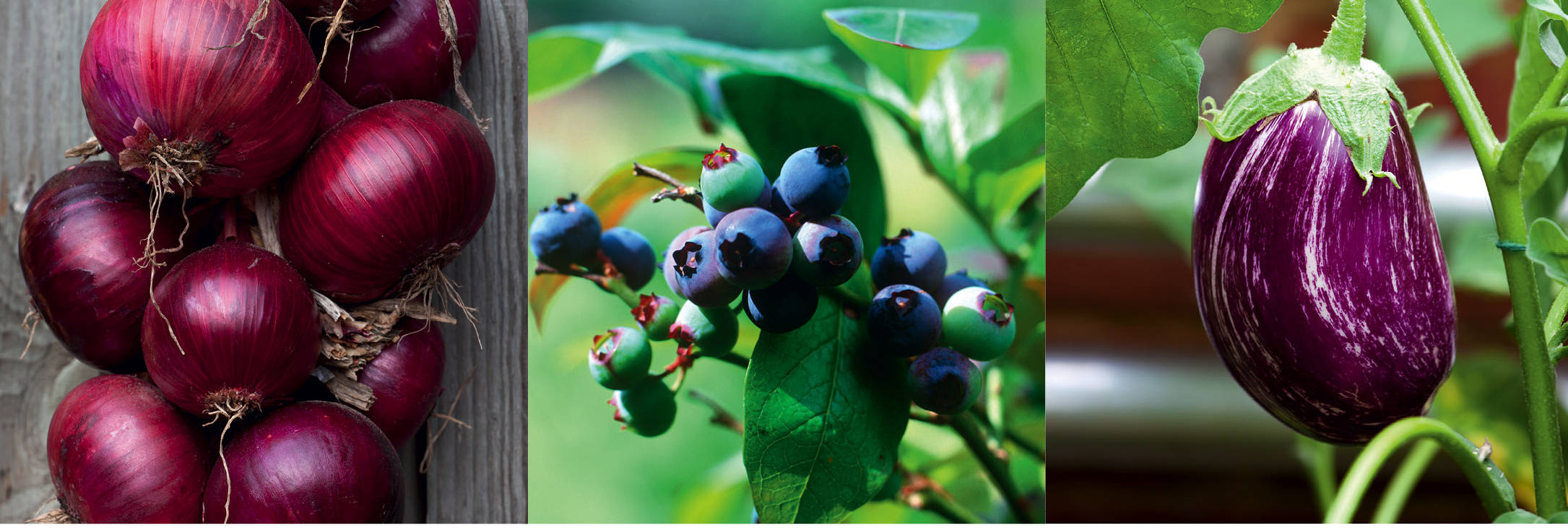
(Above, left to right)
Onions Easy to grow. Plant rows of onion sets in spring, in firm, well-drained soil in full sun. Prepare the soil in advance with well-rotted compost, as you don’t want a waterlogged heavy soil. Just remember to weed well. Ripened and ready for lifting by early to midsummer, store until early winter. Here is a more detailed guide on how to grown onions.
Blueberries Delicious, high in antioxidants and easy to grow in acidic compost. Ideally plant in a sunny, sheltered spot, though they are tolerant of shade. Birds will also enjoy them so cover with a net as the fruits start to colour.
Aubergines Treat them much as you would growing tomatoes. Sow seeds in spring and place in a propagator or on a warm indoor windowsill. They need plenty of warmth, ideally in a greenhouse or cold frame. If you have a sunny, sheltered position you can grow them outside, and they are easily moved around if grown in a container.
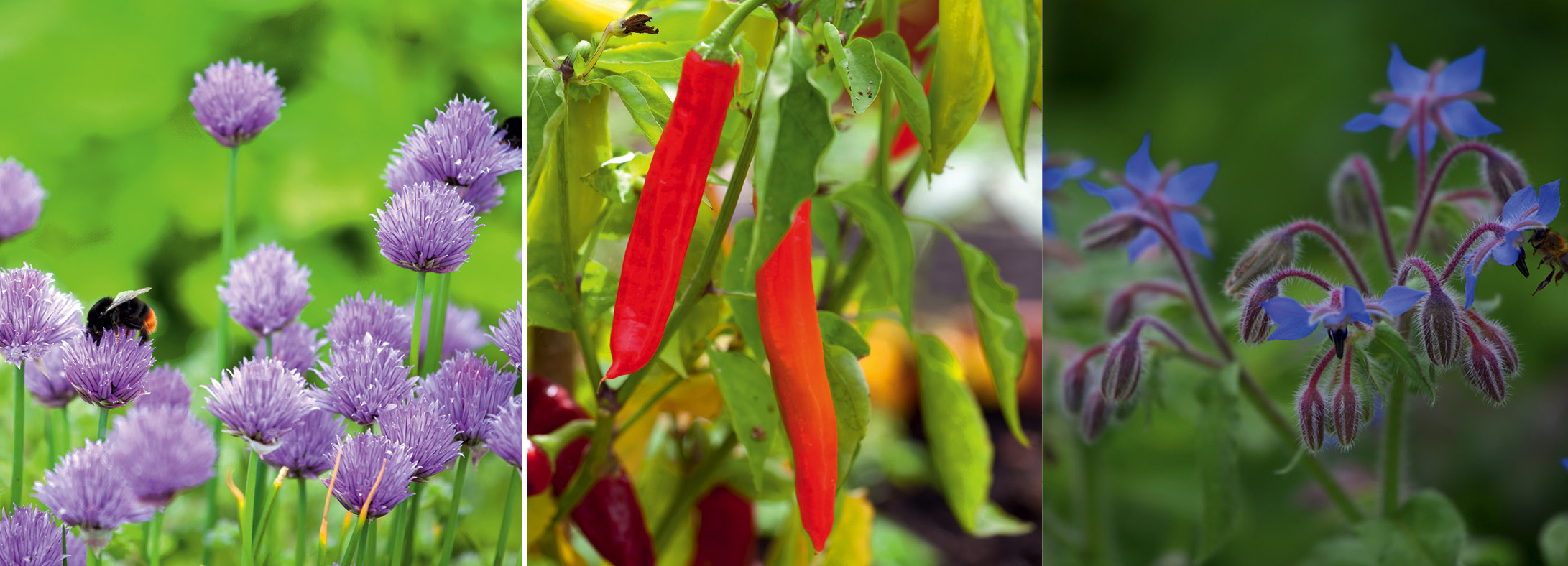
(Above, left to right)
Chives Cold hardy, but need well-drained soil. Both leaves and flowers are edible. Sow seeds directly into the soil as soon as it is workable. Chives are also very easily transplanted in case you want to dig up the plants and move them to another area.
Chilli Peppers Colourful and diverse, they are a favourite for growing in pots. The more controlled environment of a pot allows for easy weeding and watering. Most species of pepper respond well to sunlight and warm weather and attract relatively few pests.
Borage It is a useful annual herb for a sunny, sheltered spot, with delicate blue flowers that are a magnet for pollinators. Easily grown from seed and spreads quite rapidly. The leaves have a mild cucumber flavour and can be eaten in salads and soups or brewed as a tea, while the flowers are edible as well, in salads or frozen in ice cubes to brighten up drinks. (Note: borage should not be eaten by pregnant women or nursing mothers). Companion plant by tomatoes, aubergines and courgettes, good as a green manure, and also said to improve the flavour of strawberries
More gardening advice
- How to choose the best garden plants
- How to create a living wall: ideas and inspiration for a vertical garden
- How to grow basil
- How to grow mint: easy growing tips and advice
Join our newsletter
Get small space home decor ideas, celeb inspiration, DIY tips and more, straight to your inbox!
-
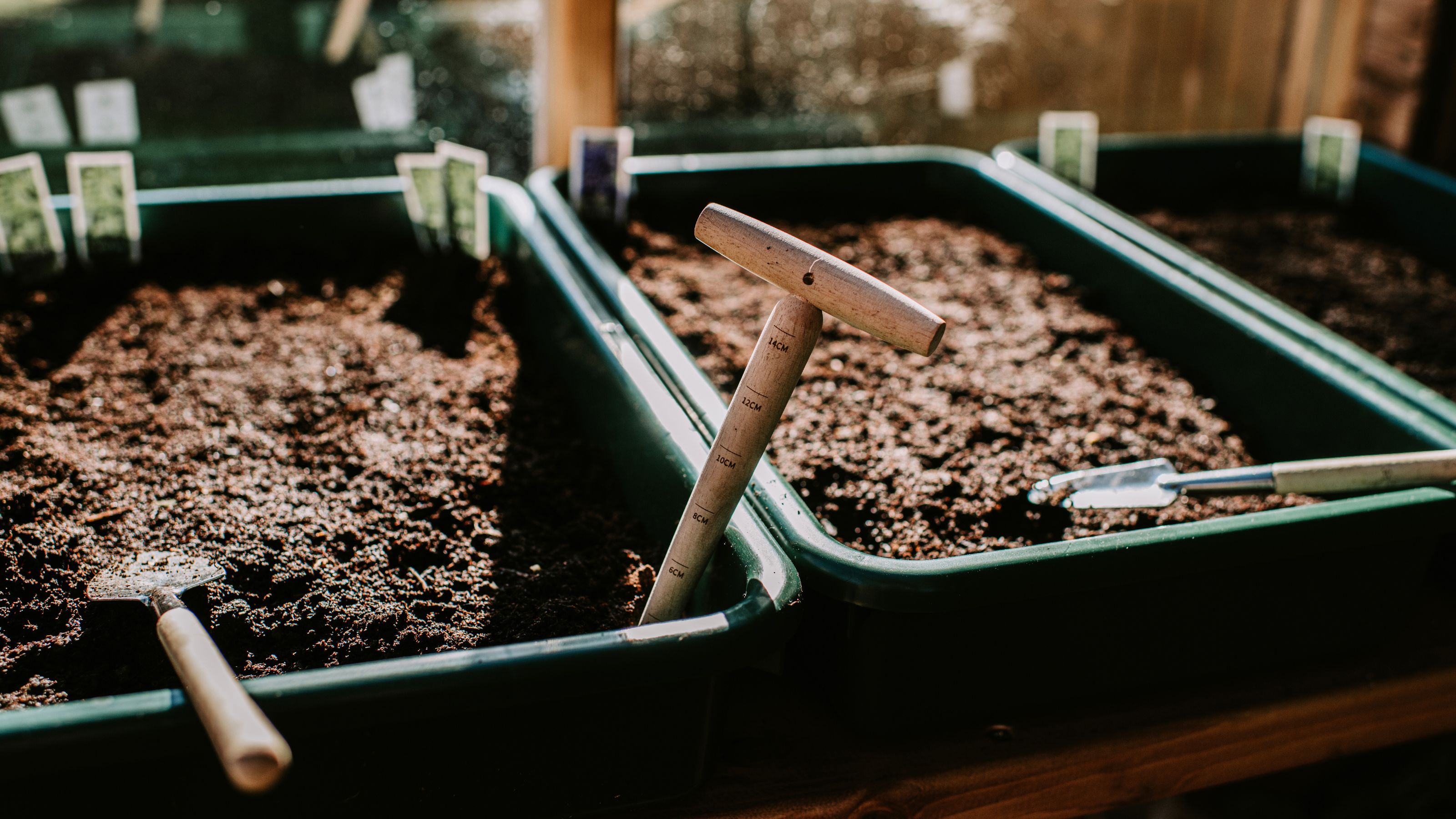 How to make compost — 8 easy steps gardening pros always use
How to make compost — 8 easy steps gardening pros always useLearn how to make compost at home in seven easy steps, whether you have a bin or want to create a compost heap. We've asked pros for their top tips
By Eve Smallman Published
-
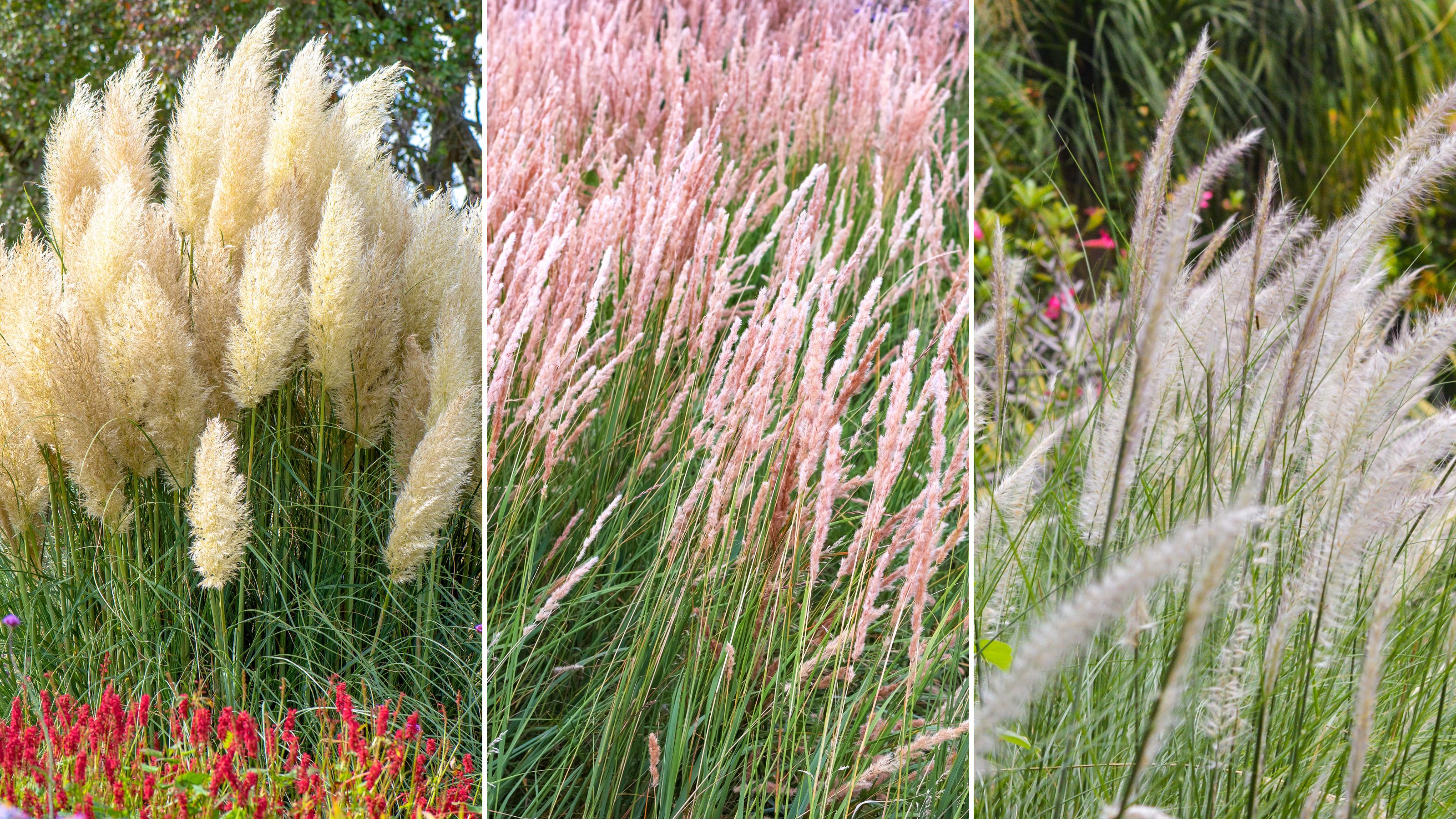 Planting ornamental grasses — the best types experts love and how to grow them
Planting ornamental grasses — the best types experts love and how to grow themWe've got you covered on planting ornamental grasses, speaking to experts about what ones to grow, how to grow them, and factors to consider
By Eve Smallman Last updated
-
 "Grotty" terrace is transformed with French flair and Ibiza vibes in the garden
"Grotty" terrace is transformed with French flair and Ibiza vibes in the gardenEsther Pillans' tired-looking Victorian terraced house was given a makeover with a touch of Parisian chic
By Ellen Finch Published
-
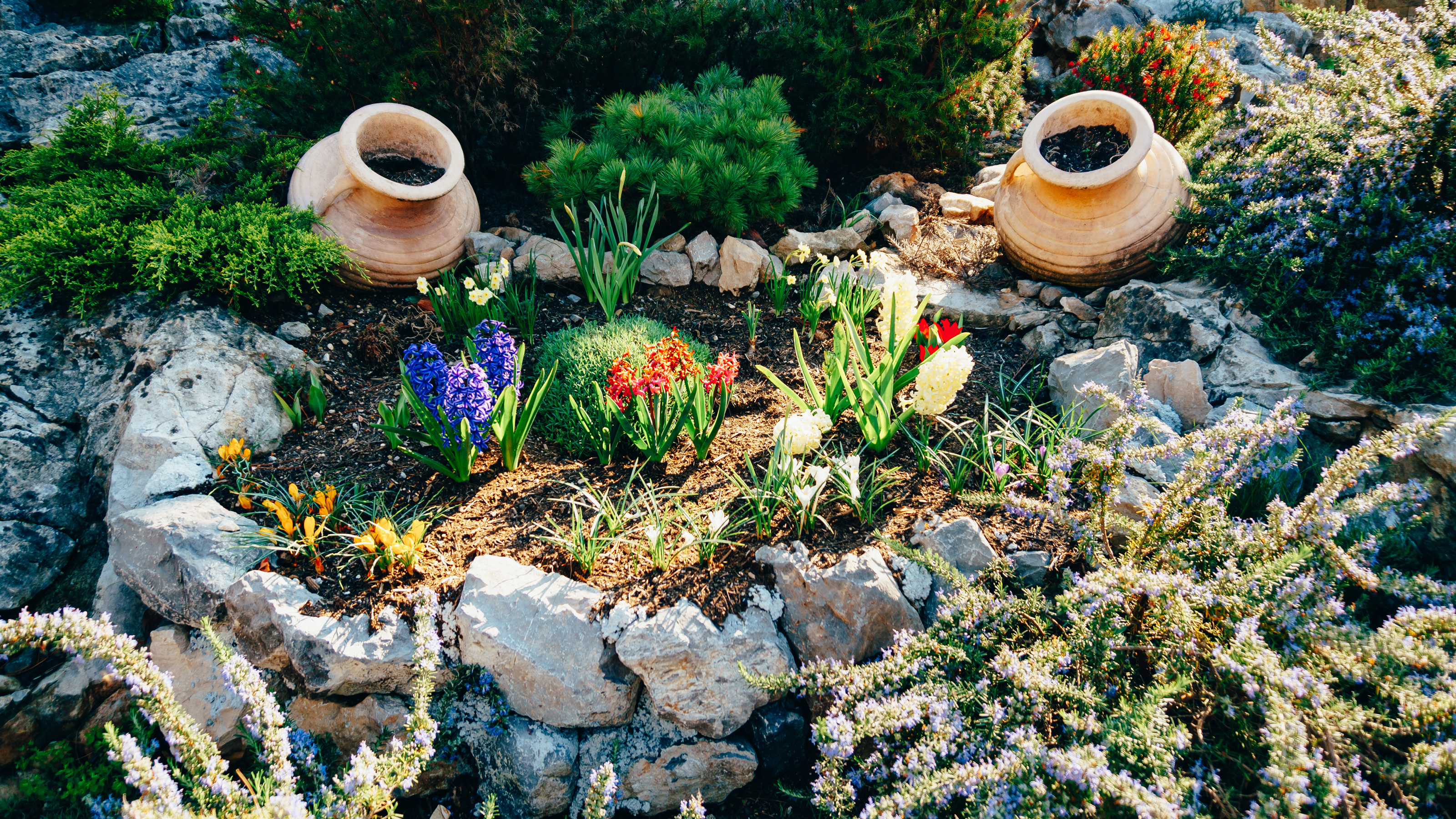 Rock garden ideas – 10 DIY ways to create a rockery
Rock garden ideas – 10 DIY ways to create a rockeryThese rock garden ideas are suitable for outdoor spaces big and small. Create your own rockery on a lawn or even on a balcony with just a few materials.
By Anna Cottrell Published
-
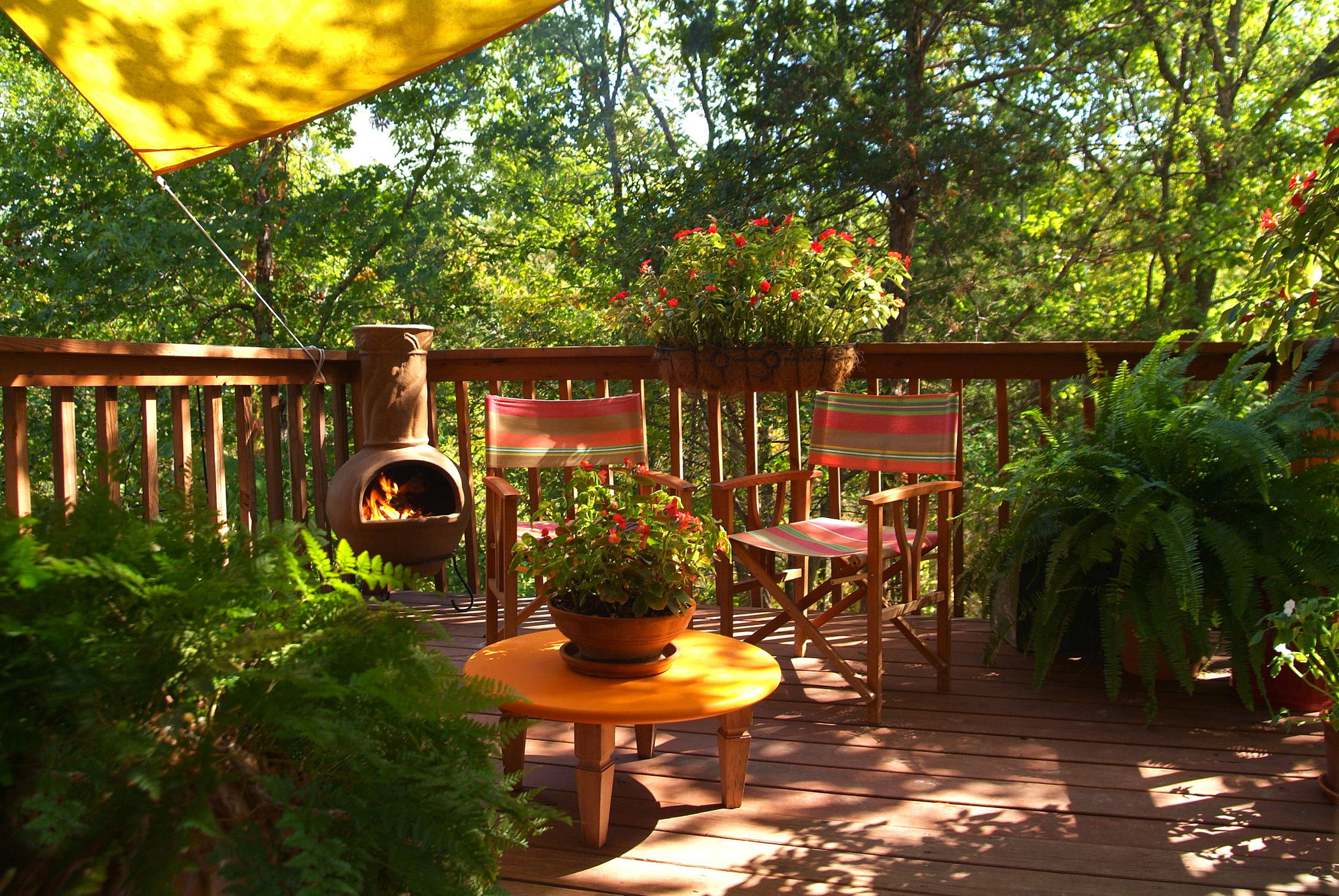 Cabin fever? These chimineas will extend the life of your patio
Cabin fever? These chimineas will extend the life of your patioThis cold-weather season, cozy up to our favorite chimineas!
By Brittany Romano Published
-
 5 outdoor summer essentials to prove Society6 is your one-stop-shop this season
5 outdoor summer essentials to prove Society6 is your one-stop-shop this seasonCheck off all of your outdoor summer essentials by shopping exclusively at Society6.
By Brittany Romano Published
-
 The first-ever Etsy outdoor sale is happening now, and we're buying these 5 items
The first-ever Etsy outdoor sale is happening now, and we're buying these 5 itemsFor a limited time, this Etsy outdoor sale will give your backyard the facelift it needs — at a fraction of the cost.
By Brittany Romano Published
-
 The benefits of houseplants – 8 feel-good ways plants help your health
The benefits of houseplants – 8 feel-good ways plants help your healthEnjoy the many benefits of houseplants. Air-purifying, anxiety-soothing, mood boosting and more positive vibes.
By Camille Dubuis-Welch Published